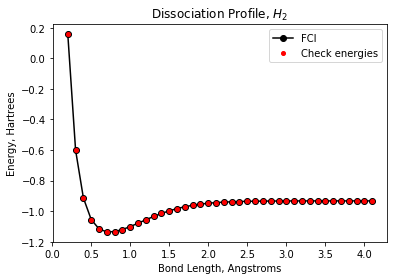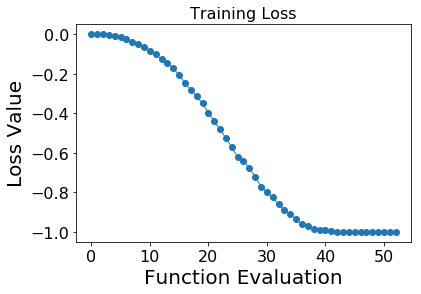Demo: Compressing ground states of molecular hydrogen¶
In this demo, we will try to compress ground states of molecular hydrogen at various bond lengths. We start with expressing each state using 4 qubits and try to compress the information to 1 qubit (i.e. implement a 4-1-4 quantum autoencoder).
In the following section, we review both the full and halfway training schemes. However, in the notebook, we execute the halfway training case.
Background: Full cost function training¶
The QAE circuit for full cost function training looks like the following:
We note that our setup is different from what was proposed in the original paper. As shown in the figure above, we use 7 total qubits for the 4-1-4 autoencoder, using the last 3 qubits (qubits , , and ) as refresh qubits. The unitary represents the state preparation circuit, gates implemented to produce the input data set. The unitary represents the training circuit that will be responsible for representing the data set using a fewer number of qubits, in this case using a single qubit. The tilde symbol above the daggered operations indicates that the qubit indexing has been adjusted such that , , , and . For clarity, refer to the figure below for an equivalent circuit with the refresh qubits moved around. So qubit is to be the “latent space qubit,” or qubit to hold the compressed information. Using the circuit structure above (applying and then effectively un-applying and ), we train the autoencoder by propagating the QAE circuit with proposed parameters and computing the probability of obtaining measurements of 0000 for the latent space and refresh qubits ( to ). We negate this value for casting as a minimization problem and average over the training set to compute a single loss value.
Background: Halfway cost function training¶
In the halfway cost function training case, the circuit looks like the following:
Here, the cost function is the negated probability of obtaining the measurement 000 for the trash qubits.
Demo Outline¶
We break down this demo into the following steps: 1. Preparation of the quantum data 2. Initializing the QAE 2. Setting up the Forest connection 3. Dividing the dataset into training and test sets 4. Training the network 5. Testing the network
NOTE: While the QCompress framework was developed to execute on both the QVM and the QPU (i.e. simulator and quantum device, respectively), this particular demo runs a simulation (i.e. uses QVM).
Let us begin! Note that this tutorial requires installation of `OpenFermion <https://github.com/quantumlib/OpenFermion>`__!
[1]:
# Import modules
%matplotlib inline
import matplotlib.pyplot as plt
import numpy as np
import os
from openfermion.hamiltonians import MolecularData
from openfermion.transforms import get_sparse_operator, jordan_wigner
from openfermion.utils import get_ground_state
from pyquil.api import WavefunctionSimulator
from pyquil.gates import *
from pyquil import Program
import demo_utils
from qcompress.qae_engine import *
from qcompress.utils import *
from qcompress.config import DATA_DIRECTORY
global pi
pi = np.pi
QAE Settings¶
In the cell below, we enter the settings for the QAE.
NOTE: Because QCompress was designed to run on the quantum device (as well as the simulator), we need to anticipate nontrival mappings between abstract qubits and physical qubits. The dictionaries q_in, q_latent, and q_refresh are abstract-to-physical qubit mappings for the input, latent space, and refresh qubits respectively. A cool plug-in/feature to add would be to have an automated “qubit mapper” to determine the optimal or near-optimal abstract-to-physical qubit mappings for
a particular QAE instance.
In this simulation, we will skip the circuit compilation step by turning off compile_program.
[2]:
### QAE setup options
# Abstract-to-physical qubit mapping
q_in = {'q0': 0, 'q1': 1, 'q2': 2, 'q3': 3} # Input qubits
q_latent = {'q3': 3} # Latent space qubits
q_refresh = None
# Training scheme: Halfway
trash_training = True
# Simulator settings
cxn_setting = '4q-qvm'
compile_program = False
n_shots = 3000
Qubit labeling¶
In the cell below, we produce lists of ordered physical qubit indices involved in the compression and recovery maps of the quantum autoencoder. Depending on the training and reset schemes, we may use different qubits for the compression vs. recovery.
Since we’re employing the halfway training scheme, we don’t need to assign the qubit labels for the recovery process.
[3]:
compression_indices = order_qubit_labels(q_in).tolist()
if not trash_training:
q_out = merge_two_dicts(q_latent, q_refresh)
recovery_indices = order_qubit_labels(q_out).tolist()
if not reset:
recovery_indices = recovery_indices[::-1]
print("Physical qubit indices for compression : {0}".format(compression_indices))
Physical qubit indices for compression : [0, 1, 2, 3]
Generating input data¶
We use routines from OpenFermion, forestopenfermion, and grove to generate the input data set. We’ve provided the molecular data files for you, which were generated using OpenFermion’s plugin OpenFermion-Psi4.
[4]:
qvm = WavefunctionSimulator()
# MolecularData settings
molecule_name = "H2"
basis = "sto-3g"
multiplicity = "singlet"
dist_list = np.arange(0.2, 4.2, 0.1)
# Lists to store HF and FCI energies
hf_energies = []
fci_energies = []
check_energies = []
# Lists to store state preparation circuits
list_SP_circuits = []
list_SP_circuits_dag = []
for dist in dist_list:
# Fetch file path
dist = "{0:.1f}".format(dist)
file_path = os.path.join(DATA_DIRECTORY, "{0}_{1}_{2}_{3}.hdf5".format(molecule_name,
basis,
multiplicity,
dist))
# Extract molecular info
molecule = MolecularData(filename=file_path)
n_qubits = molecule.n_qubits
hf_energies.append(molecule.hf_energy)
fci_energies.append(molecule.fci_energy)
molecular_ham = molecule.get_molecular_hamiltonian()
# Set up hamiltonian in qubit basis
qubit_ham = jordan_wigner(molecular_ham)
# Convert from OpenFermion's to PyQuil's data type (QubitOperator to PauliTerm/PauliSum)
qubit_ham_pyquil = demo_utils.qubitop_to_pyquilpauli(qubit_ham)
# Sanity check: Obtain ground state energy and check with MolecularData's FCI energy
molecular_ham_sparse = get_sparse_operator(operator=molecular_ham, n_qubits=n_qubits)
ground_energy, ground_state = get_ground_state(molecular_ham_sparse)
assert np.isclose(molecule.fci_energy, ground_energy)
# Generate unitary to prepare ground states
state_prep_unitary = demo_utils.create_arbitrary_state(
ground_state,
qubits=compression_indices)
if not trash_training:
if reset:
# Generate daggered state prep unitary (WITH NEW/ADJUSTED INDICES!)
state_prep_unitary_dag = demo_utils.create_arbitrary_state(
ground_state,
qubits=compression_indices).dagger()
else:
# Generate daggered state prep unitary (WITH NEW/ADJUSTED INDICES!)
state_prep_unitary_dag = demo_utils.create_arbitrary_state(
ground_state,
qubits=recovery_indices).dagger()
# Sanity check: Compute energy wrt wavefunction evolved under state_prep_unitary
wfn = qvm.wavefunction(state_prep_unitary)
ket = wfn.amplitudes
bra = np.transpose(np.conjugate(wfn.amplitudes))
ham_matrix = molecular_ham_sparse.toarray()
energy_expectation = np.dot(bra, np.dot(ham_matrix, ket))
check_energies.append(energy_expectation)
# Store circuits
list_SP_circuits.append(state_prep_unitary)
if not trash_training:
list_SP_circuits_dag.append(state_prep_unitary_dag)
[ ]:
Plotting the energies of the input data set¶
To (visually) check our state preparation circuits, we run these circuits and plot the energies. The “check” energies overlay nicely with the FCI energies.
[5]:
imag_components = np.array([E.imag for E in check_energies])
assert np.isclose(imag_components, np.zeros(len(imag_components))).all()
check_energies = [E.real for E in check_energies]
plt.plot(dist_list, fci_energies, 'ko-', markersize=6, label='FCI')
plt.plot(dist_list, check_energies, 'ro', markersize=4, label='Check energies')
plt.title("Dissociation Profile, $H_2$")
plt.xlabel("Bond Length, Angstroms")
plt.ylabel("Energy, Hartrees")
plt.legend()
plt.show()

[ ]:
Training circuit for QAE¶
Now we want to choose a parametrized circuit with which we hope to train to compress the input quantum data set.
For this demonstration, we use a simple two-parameter circuit, as shown below.
NOTE: For more general data sets (and general circuits), we may need to run multiple instances of the QAE with different initial guesses to find a good compression circuit.
[6]:
def _training_circuit(theta, qubit_indices):
"""
Returns parametrized/training circuit.
:param theta: (list or numpy.array, required) Vector of training parameters
:param qubit_indices: (list, required) List of qubit indices
:returns: Training circuit
:rtype: pyquil.quil.Program
"""
circuit = Program()
circuit.inst(Program(RX(theta[0], qubit_indices[2]),
RX(theta[1], qubit_indices[3])))
circuit.inst(Program(CNOT(qubit_indices[2], qubit_indices[0]),
CNOT(qubit_indices[3], qubit_indices[1]),
CNOT(qubit_indices[3], qubit_indices[2])))
return circuit
def _training_circuit_dag(theta, qubit_indices):
"""
Returns the daggered parametrized/training circuit.
:param theta: (list or numpy.array, required) Vector of training parameters
:param qubit_indices: (list, required) List of qubit indices
:returns: Daggered training circuit
:rtype: pyquil.quil.Program
"""
circuit = Program()
circuit.inst(Program(CNOT(qubit_indices[3], qubit_indices[2]),
CNOT(qubit_indices[3], qubit_indices[1]),
CNOT(qubit_indices[2], qubit_indices[0])))
circuit.inst(Program(RX(-theta[1], qubit_indices[3]),
RX(-theta[0], qubit_indices[2])))
return circuit
[7]:
training_circuit = lambda param : _training_circuit(param, compression_indices)
if not trash_training:
if reset:
training_circuit_dag = lambda param : _training_circuit_dag(param,
compression_indices)
else:
training_circuit_dag = lambda param : _training_circuit_dag(param,
recovery_indices)
[ ]:
Initialize the QAE engine¶
Here we create an instance of the quantum_autoencoder class.
Leveraging the features of the Forest platform, this quantum autoencoder “engine” allows you to run a noisy version of the QVM to get a sense of how the autoencoder performs under noise (but qvm is noiseless in this demo). In addition, the user can also run this instance on the quantum device (assuming the user is given access to one of Rigetti Computing’s available QPUs).
[8]:
qae = quantum_autoencoder(state_prep_circuits=list_SP_circuits,
training_circuit=training_circuit,
q_in=q_in,
q_latent=q_latent,
q_refresh=q_refresh,
trash_training=trash_training,
compile_program=compile_program,
n_shots=n_shots,
print_interval=1)
After defining the instance, we set up the Forest connection (in this case, a simulator).
[9]:
qae.setup_forest_cxn(cxn_setting)
Let’s split the data set into training and test set. If we don’t input the argument train_indices, the data set will be randomly split. However, knowing our quantum data set, we may want to choose various regions along the PES (the energy curve shown above) to train the entire function. Here, we pick 6 out of 40 data points for our training set.
[10]:
qae.train_test_split(train_indices=[3, 10, 15, 20, 30, 35])
Let’s print some information about the QAE instance.
[11]:
print(qae)
QCompress Setting
=================
QAE type: 4-1-4
Data size: 40
Training set size: 6
Training mode: halfway cost function
Compile program: False
Forest connection: 4q-qvm
Connection type: QVM
[ ]:
Training¶
The autoencoder is trained in the cell below, where the default optimization algorithm is Constrained Optimization BY Linear Approximation (COBYLA). The lowest possible mean loss value is -1.000.
[12]:
%%time
initial_guess = [pi/2., 0.]
avg_loss_train = qae.train(initial_guess)
Iter 0 Mean Loss: -0.0000000
Iter 1 Mean Loss: -0.0000000
Iter 2 Mean Loss: -0.0011667
Iter 3 Mean Loss: -0.0043333
Iter 4 Mean Loss: -0.0111667
Iter 5 Mean Loss: -0.0157778
Iter 6 Mean Loss: -0.0258889
Iter 7 Mean Loss: -0.0393889
Iter 8 Mean Loss: -0.0510556
Iter 9 Mean Loss: -0.0647778
Iter 10 Mean Loss: -0.0860556
Iter 11 Mean Loss: -0.1017778
Iter 12 Mean Loss: -0.1266111
Iter 13 Mean Loss: -0.1475000
Iter 14 Mean Loss: -0.1716667
Iter 15 Mean Loss: -0.2078889
Iter 16 Mean Loss: -0.2444444
Iter 17 Mean Loss: -0.2815000
Iter 18 Mean Loss: -0.3136667
Iter 19 Mean Loss: -0.3497778
Iter 20 Mean Loss: -0.3960556
Iter 21 Mean Loss: -0.4407778
Iter 22 Mean Loss: -0.4816667
Iter 23 Mean Loss: -0.5263333
Iter 24 Mean Loss: -0.5710556
Iter 25 Mean Loss: -0.6225000
Iter 26 Mean Loss: -0.6395556
Iter 27 Mean Loss: -0.6777778
Iter 28 Mean Loss: -0.7205556
Iter 29 Mean Loss: -0.7716667
Iter 30 Mean Loss: -0.7977222
Iter 31 Mean Loss: -0.8250556
Iter 32 Mean Loss: -0.8601111
Iter 33 Mean Loss: -0.8893333
Iter 34 Mean Loss: -0.9110556
Iter 35 Mean Loss: -0.9350556
Iter 36 Mean Loss: -0.9600000
Iter 37 Mean Loss: -0.9718333
Iter 38 Mean Loss: -0.9843333
Iter 39 Mean Loss: -0.9901111
Iter 40 Mean Loss: -0.9892222
Iter 41 Mean Loss: -0.9955556
Iter 42 Mean Loss: -0.9981111
Iter 43 Mean Loss: -0.9992222
Iter 44 Mean Loss: -1.0000000
Iter 45 Mean Loss: -0.9997222
Iter 46 Mean Loss: -0.9996667
Iter 47 Mean Loss: -1.0000000
Iter 48 Mean Loss: -1.0000000
Iter 49 Mean Loss: -1.0000000
Iter 50 Mean Loss: -1.0000000
Iter 51 Mean Loss: -1.0000000
Iter 52 Mean Loss: -1.0000000
Mean loss for training data: -1.0
CPU times: user 3.74 s, sys: 78.5 ms, total: 3.82 s
Wall time: 2min 17s
Plot training losses¶
[14]:
fig = plt.figure(figsize=(6, 4))
plt.plot(qae.train_history, 'o-', linewidth=1)
plt.title("Training Loss", fontsize=16)
plt.xlabel("Function Evaluation",fontsize=20)
plt.ylabel("Loss Value", fontsize=20)
plt.xticks(fontsize=16)
plt.yticks(fontsize=16)
plt.show()

Testing¶
Now test the optimized network against the rest of the data set (i.e. use the optimized parameters to try to compress then recover each test data point).
[15]:
avg_loss_test = qae.predict()
Iter 53 Mean Loss: -0.9999804
Mean loss for test data: -0.9999803921568627
[ ]: